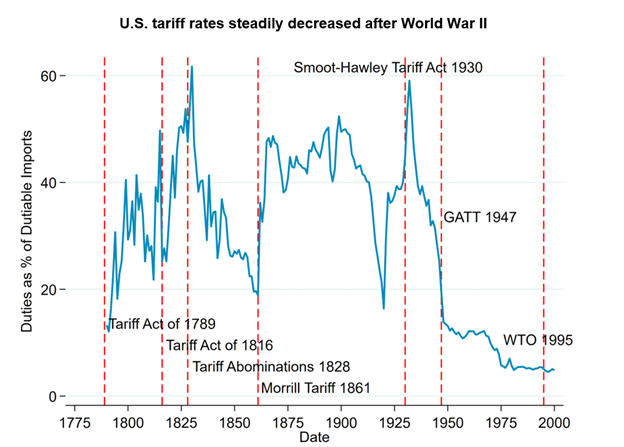

Tariffs are taxes that countries impose on imported goods when they cross the border. From the founding of the United States until 1914, when the federal income tax was introduced, tariffs were the main source of revenue to the federal government. After World War II, the U.S. joined the General Agreement on Tariffs and Trade (GATT) with 22 other countries, which aimed to promote international trade, and began decreasing tariffs. The downward trend in tariff rates continued until 2018, when the Trump administration raised tariffs on several products, especially those imported from China, igniting a trade war. Tariffs on China stopped increasing in January 2020 but have yet to decrease substantially, and remain well above their pre-2018 levels. The Biden administration has kept Trump-era tariffs on China in place and raised them on steel, aluminum, medical equipment, electric vehicles, lithium-ion batteries, and solar cells in May 2024. Unlike other taxes, which require the consent of Congress, legislation passed in 1934, 1962, and 1974 gives the executive branch leeway to lower tariff rates by up to 80% and to raise tariff rates if it serves a national security interest.

Among the reasons that countries impose tariffs are to protect domestic industries (particularly those vital to national security), to incentivize foreign countries to change their practices, and to raise revenue. The Trump and Biden administrations said they imposed tariffs for the first two reasons.
Even with the tariffs imposed during the Trump and Biden administrations, tariff revenues in fiscal year 2023 were slightly more than $80 billion, a small fraction of the $4.439 trillion in total U.S government revenues for that year. The global proliferation of free agreements since World War II has substantially lowered tariff rates, and in turn lowered tariff revenue in wealthy countries, though a number of developing countries still rely on tariffs for a substantial proportion of government revenues.

The Trump administration argued tariffs were “imposed to encourage China to change [its] unfair practices,” as they were “threatening United States companies, workers, and farmers.” This statement cited a report from the Office of the United States Trade Representative which found that China’s actions “pressure technology transfer from U.S. companies to Chinese entities … deprive U.S. technology owners of the ability to bargain … and support unauthorized intrusions into, and theft from, the computer networks of U.S. companies.” The administration argued in January 2018 that its initial round of tariffs on washing machines was necessary, as increasing imports had hurt American washing machine manufacturers’ financial performance. The tariffs, which made imports more expensive, were supposed to increase domestic purchases of washing machines. Trump’s U.S. Trade Representative Robert Lighthizer also argued in July of that year that “China [had] been engaging in industrial policy which [had] resulted in the transfer and theft of intellectual property and technology to the detriment of our economy,” prompting punitive tariffs to spur a change in policy. Trump frequently cited China’s business practices as the cause of the trade deficit between the U.S. and China, saying in June 2018 that “the United States [is] at a permanent and unfair disadvantage, which is reflected in our massive $376 billion trade imbalance in goods.”
China responded to the initial round with retaliatory tariffs. This prompted both countries to continue increasing tariffs for the better part of two years. The U.S.-China trade war paused in January 2020, when the U.S. agreed not to impose planned tariffs on China, and China agreed to buy more U.S. exports. By this point, the level of U.S. tariffs on China had increased from under 5% to over 20%.
The Biden administration has not reduced any of Trump’s tariffs on China, and in May 2024 raised tariffs on steel, aluminum, medical equipment, lithium-ion batteries, and solar cells.
Biden’s May 2024 tariff increases follow much of the same logic as Trump’s initial 2018 tariffs, albeit without mention of the U.S. trade deficit with China. In its release, the administration argued that “American workers continue to face unfair competition from China’s non-market overcapacity in steel and aluminum” and “encourage[d] China to eliminate its unfair trade practices.” The Biden administration, like the Trump administration, sees tariffs on China as both a punitive measure that might spur a change in Chinese industrial policy as well a way to protect domestic manufacturers.
Though the Biden administration has drawn criticism from advocates of free trade in both parties for keeping protectionist trade policy, he also has important constituents who want to keep tariffs in place. At the start of his term, the U.S. steel industry, including its union workers, urged Biden to hold steady. In November 2023, Democratic senators Bob Casey Jr. and Sherrod Brown, both from Rust Belt states with many union workers, wrote a letter to Biden arguing that tariffs on steel and aluminum were still necessary.
U.S. Trade Representative Katherine Tai was asked at a June 2024 event at the Atlantic Council where she agrees and differs with Trump’s former USTR Robert Lighthizer. She said they agree the U.S. has to “change [its] approach to trade,” that she and Lighthizer “share a lot of the same diagnoses” on the U.S.-China trade relationship, and that “one of the ways where Bob and I are most different is in rhetoric.” While many economists and some policymakers in the past have emphasized the benefits of trade to American consumers, Tai and Lighthizer emphasize the risks that trade poses to American workers. For more on Tai’s views, see this interview from Vox.com. For more on Lighthizer’s commentary, see this site, or his 2023 book, “No Trade is Free.”
The burden of tariffs can fall on consumers (who may pay higher prices), on importers (who may absorb the cost by reducing their profits and not pass it along to consumers), on exporters (who may absorb the cost and accept lower net prices for their goods), or on some mix of those. Tariffs are often imposed on intermediate goods—goods that are used in the production of things that consumers buy—and this can both erode producers’ profits (unless they find domestic substitutes for those inputs) and the prices they charge consumers. Which party bears the heaviest burden depends on the specific market.
A literature review by the Tax Foundation found that U.S. consumers and firms bore the brunt of costs in the recent trade war, with some studies finding partial pass-through (the price increases, but not by as much as the tariff, hurting both importers and consumers), others finding almost complete pass-through (the price increases by the amount of the tariff), and a couple of cases of over-shifting (the price increases by more than the amount of the tariff). They did not find substantial evidence that foreign exporters absorbed the economic burden of the tariffs by lowering prices.
The Congressional Budget Office (CBO) says that the effect of tariffs on output can be ambiguous. On the one hand, some consumers end up buying domestic goods instead of imported goods, and tariff revenues make more resources available for private investment by decreasing the national deficit. These factors increase GDP. On the other, the purchasing power of consumers goes down as goods are more expensive, retaliatory tariffs decrease exports, and some businesses delay new investments out of caution. These factors all decrease GDP.
On balance, economists tend to agree that free trade (low tariffs) increases economic growth more than protectionist trade policy (high tariffs). Free trade allows producers with comparative advantage to get their products to the market cheaply and efficiently, and tariffs get in the way. Additionally, while tariffs may protect infant industries, they can also reduce competition, with adverse effects on an economy. In the 20 th century, many developing countries put large tariffs on imported goods using a strategy called “import substitution” to give a country’s domestic industries a leg up until they could compete with advanced countries. In practice, those industries often remained underdeveloped, as they never had to compete with better technology.
Today’s advocates of tariffs say that the textbook models don’t resemble reality because China, in particular, heavily subsidizes key industries and gives them an advantage of over American producers—and could put them out of business altogether, giving China a monopoly.
In August 2019, CBO estimated that the negative GDP effects of recent tariff increases had outweighed the positive ones and were decreasing real output by 0.3%. The Tax Foundation estimated in July 2023 that the long-run effects would bring GDP down by 0.2% and total employment down by 142,000 jobs. Economists Mary Amiti of the New York Fed, Stephen Redding of Princeton, and David Weinstein of Columbia found, in a 2020 working paper, that “U.S. tariffs continue to be almost entirely borne by U.S. firms and consumers.” Michael Pettis of the Carnegie Endowment noted that, even when the U.S.-China trade deficit decreases, as it did after the tariffs, the U.S. trade deficit with the rest of the world increases by at least as much.
Those worried about the threat that China poses to U.S. prosperity say the costs imposed by tariffs are worth the benefits. Total imports from China are down from pre-2018 trends as intended, and imports from China on products with high tariffs cratered in 2019 and 2020. While this shows signs of some economic decoupling, the effects have been partially offset by a surge in Chinese imports on products without tariffs.
If messaging from the Biden administration and Trump campaign is any signal, the era of high tariffs will continue past 2024, though the nature and scope of the tariffs will depend on who wins the November 2024 election. Biden’s May 2024 tariff increases affect $18 billion worth of goods, while some Trump proposals would impose tariffs on all U.S. imports from China (over $400 billion) or on all U.S. imports (slightly under $4 trillion). After Biden’s announcement of increased tariffs in May 2024, Trump said increased tariffs should also apply to vehicles “and a lot of other products.”
In June 2024, Trump floated fully replacing the income tax with tariffs, which would effectively shift the burden of paying for government from upper-income Americans (because the income tax is progressive) to those who don’t make enough income to pay much, if any, income taxes.
Economists Kim Clausing and Maury Obstfeldt argue that replacing the income tax with tariffs is impossible:
“Tariffs are levied on imported goods, which totaled $3.1 trillion in 2023. The income tax is levied on incomes, which exceed $20 trillion; the U.S. government raises about $2 trillion in individual and corporate income taxes at present. It is literally impossible for tariffs to fully replace income taxes. Tariff rates would have to be implausibly high on such a small base of imports to replace the income tax, and as tax rates rose, the base itself would shrink as imports fall, making Trump’s $2 trillion goal unattainable.”
(This is drawn from a summary prepared by the law firm of Skadden Arps and by the Congressional Research Service.)